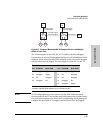
6-62
Configuring the Switch
Port-Based Virtual LANs (VLANs)
Configuring the Switch
VLAN Tagging Information
VLAN tagging enables traffic from more than one VLAN to use the same port.
(Even when two or more VLANs use the same port they remain as separate
domains and cannot receive traffic from each other without going through a
router.) As mentioned earlier, a “tag” is simply a unique VLAN identification
number (VLAN ID) assigned to a VLAN at the time that you configure the VLAN
name in the switch. In the Switches 1600M/2424M/4000M/8000M the tag can
be any number from 1 to 4095 that is not already assigned to a VLAN. When
you subsequently assign a port to a given VLAN, you need to implement the
VLAN tag (VLAN ID) only if the port will carry traffic for more than one VLAN.
Otherwise, the port VLAN assignment can remain “untagged” because the tag
is not needed. On a given switch, this means you should use the “Untagged”
designation for a port VLAN assignment where the port is connected to non
802.1Q-compliant device or is assigned to only one VLAN. Use the “Tagged”
designation when the port is assigned to more than one VLAN or the port is
connected to a device that does comply with the 802.1Q standard.
For example, if port X7 on an 802.1Q-compliant switch is assigned to only the
Red VLAN, the assignment can remain “untagged” because the port will
forward traffic only for the Red VLAN. However, if both the Red and Green
VLANs are assigned to port X7, then at least one of those VLAN assignments
must be “tagged” so that Red VLAN traffic can be distinguished from Green
VLAN traffic. The following illustration demonstrates this concept:
Figure 6-45. Example of Tagged and Untagged VLAN Port Assignments
Blue
Server
White
Server
Green
Server
Red
Server
Red
VLAN
Blue
VLAN
White
VLAN
Green
VLAN
Green
VLAN
Red
VLAN
Switch
"X"
5
6
7
4
1
3
2
Switch
"Y"
5
4
1
3
2
Red VLAN: Untagged
Green VLAN: Tagged
Ports 1-6: Untagged
Port 7: Red VLAN Untagged
Green VLAN Tagged
Ports 1-4: Untagged
Port 5: Red VLAN Untagged
Green VLAN Tagged


















